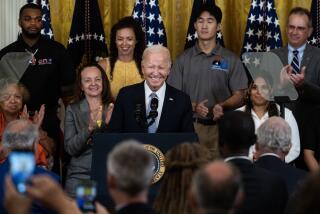Drug Makers’ Healthy Profits Stir Consumer Indignation
- Share via
The nation’s leading drug manufacturers posted sharply higher earnings this week, a bright spot in an ailing economy.
But to consumers already upset about high prices, the industry’s healthy results signal a need for reform.
The industry received a nudge in that direction Thursday when the Gray Panthers, an advocacy group, sued Bristol-Myers Squibb Co. over tactics used by the drug maker to block cheap knockoffs of a popular anti-anxiety medication.
And next week, Sen. Charles E. Schumer (D-N.Y.) and Sen. John McCain (R-Ariz.) plan to reintroduce legislation that would make it tougher for drug makers to extend patents on top-selling drugs. The legislation would close loopholes in the Hatch-Waxman Act that have allowed companies to block generic competition.
Pressure on the industry has accelerated since March, when five leading makers of AIDS medications slashed prices in sub-Saharan Africa, an action they had long resisted. The drastic reductions offer relief to Africa’s poor. But they also suggest that huge profits are built into prices of vital medications.
“What the industry has told us is the actual cost of making the medication is only 10% of the price,” said Stephen Schondelmeyer, a pharmaceutical economist and professor at the University of Minnesota. He estimated that one-third of the price charged for drugs in the United States represents advertising and marketing expenses.
That arithmetic irks senior citizens who purchase one-third of all prescription drugs. “We’re taking matters into our own hands,” Tim Fuller, Gray Panthers president, said. “We’re not stopping until we get reform.”
For its part, the industry maintains it has gotten a bad rap. Pharmaceutical Manufacturers Assn., the industry’s influential trade group, said that while pharmaceutical expenditures are growing, the actual cost of drugs is not. It said Americans spent 14.9% more on prescription medications last year than in 1999, though prices rose 3.9%
“What people see are these double-digit expenditures, and they’re surprised,” said industry spokeswoman Jackie Cottrell.
And, the industry argues, although people are shelling out more on drugs, it is money well spent. Cottrell cited a study released this year by the Tufts University Center for the Study of Drug Development, which found that doctors increasingly are using prescription drugs to treat chronic diseases instead of more costly hospital care.
Cottrell argues that the cost-savings benefit consumers. But it is good news for the industry as well. As the Tufts study notes, “Demand in the U.S. for drugs will increase significantly over the next several decades as an aging population demands more effective medicines.”
Analysts said higher demand for drugs to treat chronic and lifestyle conditions, from diabetes to obesity, is one reason why drug company earnings are strong. But besides the industry’s public relations problem over pricing, individual companies will come under pressure as patents expire on their strong-selling drugs.
Bristol-Myers Squibb, which reported a 9% increase in first-quarter profit to $1.34 billion, faces a rocky road. Its diabetes treatment, Glucophage, is expected to face generic competition by the end of the year, which could eliminate more than half of the drug’s sales. The company also faces generic competition on its breast cancer drug, Taxol, and BuSpar, the anti-anxiety pill at the center of the Gray Panther suit.
Bristol-Myers couldn’t be reached for comment on the suit, but in the past has denied any wrongdoing in connection with BuSpar.
Thousand Oaks-based Amgen Inc. reported a 15% increase in first-quarter earnings Thursday, to $305 million from $266.2 million, matching analysts’ estimates. Sales for the quarter increased to $798 million, up 14% from $698 million.
But the company’s stock fell 5% in after-hours trading on news of slower sales that came after the market closed. In a telephone conference with analysts, Amgen reduced sales forecasts for its anti-anemia drugs, the blockbuster Epogen and the second-generation Aranesp.
The company said it expects sales between $100 million and $150 million in the non-dialysis market for the drugs this year, down from $150 million to $200 million--in part because it hasn’t received government approval to market Aranesp. The company expects approval before June.
Additionally, Amgen forecast slower growth for its drugs among kidney dialysis patients, the primary market for Epogen.
Amgen’s share price closed $55.89, down $2.51 on Nasdaq.
More to Read
Inside the business of entertainment
The Wide Shot brings you news, analysis and insights on everything from streaming wars to production — and what it all means for the future.
You may occasionally receive promotional content from the Los Angeles Times.










